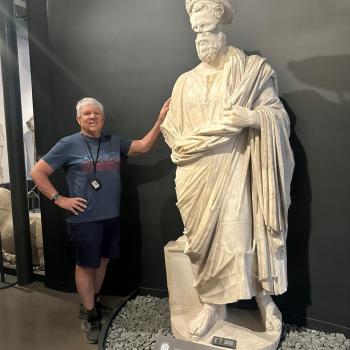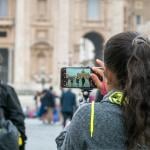(An eight century panel painting in iconic style of Christ and St. Menas)
Here is a review of recent publications of relevance to the study of the origins of iconography by noted art historian Robin Cormack (the spouse of the equally illustrious Mary Beard) kindly sent to me by Philip Jenkins. See what you think. My view would be that we don’t have second century evidence of the creation of icons by Christians.
Graven images
ROBIN CORMACK
Open any art-historical survey about the beginnings of Christian art, and you will find the same view expressed. It will be that there was no figurative art before around 200 AD, and that Christian art only began in the third century. The first surviving evidence on this scenario is funerary sculpture and the catacombs at Rome, but most significant are the figurative wall paintings of the Christian house church at Dura Europos on the eastern border of Roman Syria. These paintings in the Baptistery were excavated in the 1920s and are now in the Yale University Art Gallery. The same frontier city had paintings in its pagan temples, and, more surprisingly, paintings of biblical subjects on the walls of the synagogue (now in the National Museum of Damascus). Since Dura was destroyed by the Sassanians in 256 and totally abandoned, all this material predates that event, and the Jewish and Christian paintings belong in the second quarter of the third century. Their production is often attributed to the missionary zeal of rival religions, using art as aids to conversion. But it remains difficult to explain both the gap in the production of Christian art since the time of Christ, and its apparently sudden emergence in the third century. Was this due to opposition to all art because art was a marker of paganism? Was it adherence to the Second Commandment? Was art regarded as unnecessary in view of the imminent Second Coming of Christ? These are only three of many suggested explanations.
Thomas Mathews and Norman Muller (who contributes important observations on the carpentry and technical aspects of the paintings) offer a radical alternative picture, based on years of research into Egyptian painting from the Roman period, supported by the Kress and Getty Foundations, and published in this gorgeously illustrated book by the J. Paul Getty Museum at Los Angeles. Their insights into the importance of this material are, one must add, anticipated by an equally informative book by Vincent Rondot, DerniersVisages des dieux d’Égypte: Iconographies, panthéons et cultes dans le Fayoum hellénisé des IIe-IIIe siècles denotre ère (2013). That work was a revelation of little noticed materials and catalogued a surprising number of surviving painted panels which were made for use in the cult of pagan gods in Egypt, mostly in the second century AD. Mathews proposes that pagan Egyptian panels and early Christian icons have in common the same ancient religious function – they were produced in order to act as “votive” offerings to the divinity by depositing an image of the god in a sacred place (which might be a temple or a shrine in the home). He argues (in a series of vignettes) that both paintings speak the same visual language and technically are allied by their use of egg tempera as a medium. He finds syncretism an uncomplicated word to describe this apparent continuity from pagan to Christian art. These pagan votive images are very different in purpose from the well-known painted panel portraits of the deceased which were made to be inserted into their mummies in the Fayyum from the second to the fourth centuries, and which are known from the excavations of Flinders Petrie and others. Over one thousand have been preserved.
Despite the title of the book, focusing on the beginnings of this tradition, this is essentially an attempt to rewrite the history of the Byzantine icon from its beginnings up to the tenth century, and to suggest that icons were a regular part of Christian devotions from early on. To make his case for continuity between pagan and Christian images, Mathews has recourse to a number of texts as well as the material evidence. He quotes St Clement of Alexandria writing at the end of the second century as mentioning paintings of Aphrodite in pagan houses. But since Clement is critical of the practice, and makes it clear that Christians would not need such images, this text is more easily taken to support the interpretation of early Christians as a group spurning figurative art. However, Mathews thinks he has found a conclusive text to document the production of Christian icons during the second century. He claims it proves that the Christian community in Asia Minor already possessed one or more icons of St John at that time, and he castigates its omission from the history of art as “a grave suppression of evidence”. He is referring to the apocryphal stories of the life of St John, known as the Acts of St John, which he accepts as having been written in the second quarter of the second century. The relevant passage describes the raising from the dead by St John at Ephesus of the “praetor” Lykomedes and his wife, and the subsequent commission of a portrait of the saint as a votive offering of thanks. This is the crucial text for Mathews, as it seems to offer a seamless continuity from pagan to Christian icons in the second century, and to fill the awkward gap in the material evidence that no Christian icons earlier than the sixth century have been preserved. Mathews has succumbed to the temptation to accept this evidence. But the truth is that the hazards of this text have been investigated by scholars, since it was often copied, translated into several languages and expanded during the Middle Ages. It is tricky to determine what is original, where it was first written, and what was added over the centuries. Fortunately, one of the best critical reviews of the section about the painting of St John was written by an art historian, James Breckenridge, in 1974. He concluded that the text, which is strikingly similar to an anecdote about a painted portrait in Porphyry’s Life of Plotinus, cannot be used as evidence for the early Christian community, and was written in the fourth century or later.
Mathews may not have changed the conventional version of the beginnings of Christian art in the third century, but once this particular aim of the book is laid aside, there are many perceptive observations on a number of works of art. More debatable, however, is how far the amazing survival of painted panels in Egypt should be used to locate the place of Christian artistic innovations or whether similar paintings once existed but no longer survive all over the Roman Empire in which Christianity developed. Mathews’s insight on the importance of the practice of votive thanks offerings can certainly be applied all over the Mediterranean (and has been outlined in another recent publication, Alexandra Sofroniew’s Household Gods: Private devotion in ancient Greece and Rome).
Three studies stand out in the book. The first focuses on a small painted panel in Berlin (purchased in Egypt in 1932), originally square in shape, though now cut down, probably shortly before its purchase, and now circular. It is a group portrait with Septimius Severus (Emperor 193–211), his wife Julia Domna, and his two sons Caracalla and Geta (whose face has been erased, however). Mathews believes it was painted and dedicated to a temple in Egypt on the occasion of a family visit between September 199 and April 200, but that the erasure of the face of Geta (murdered in 211) occurred on the occasion of Caracalla’s second visit to Egypt in 215/6 and the rededication of the image. He also argues that the emperors are represented as Serapis. His key evidence is the papyrus Oxyrhynchus 12 1449, which lists offerings to a number of small Egyptian temples, and includes several repeated itemizations of a small icon (eikonidion) of the Emperor Caracalla and his parents. Mathews concludes that there were multiple examples of the Berlin painting in Egyptian temples, all with the subsequent erasure of Geta. He even goes on record to propose (with the help of Roger Bagnall) that there were once some 4,000 such panels, of which we have the only one to survive.
The second proposal is a reconstruction of a set of ten marble reliefs that were excavated by Martin Harrison in Istanbul in the 1960s, and which came from St Polyeuctos’s Church, a sixth-century foundation which collapsed 700 years after it was built. These reliefs depicting Mary, Jesus and ten apostles had all been mutilated, and Harrison argued that their defacement was perpetrated by Byzantine iconoclasts in the eighth century when in use as icons on a screen in the church. Mathews reconstructs this screen as the partition between the nave and the altar, though others have thought their style does not match the other surviving sixth-century sculptures, and might belong to a later phase before iconoclasm. He compares their location with the silver icons of Christ, Mary and the apostles in front of the altar of Hagia Sophia, as described in a poem celebrating the re-dedication of the cathedral in 562. His sketched reconstruction makes the plaques in St Polyeuctos’s look a little precarious in position, but his case is a good one.
The third discussion is a very helpful commentary on the precise meanings of some of the terms in the canons of the Council of Nicaea in 787. Mathews persuasively argues that the discussion was not about image theory, but was more practical and aimed to define orthodox practice in the use of icons and to legitimate their veneration. Mathews takes the traditional (and justifiable) view that iconoclasm was a major turning point in church history, and that the council was a key stage in establishing how icons might be used in prayer and in liturgy.













